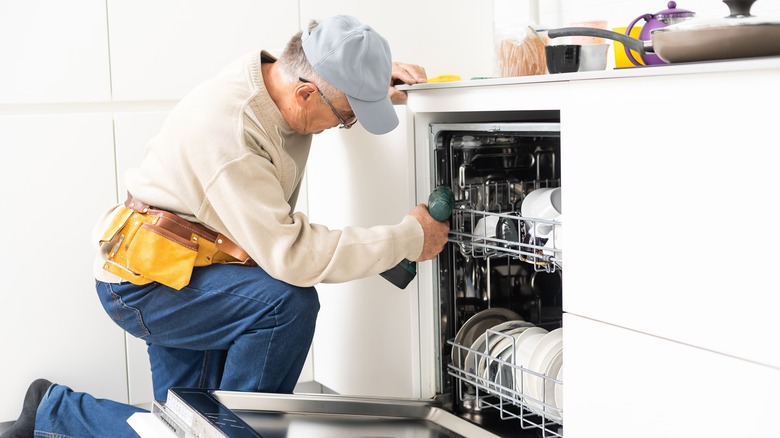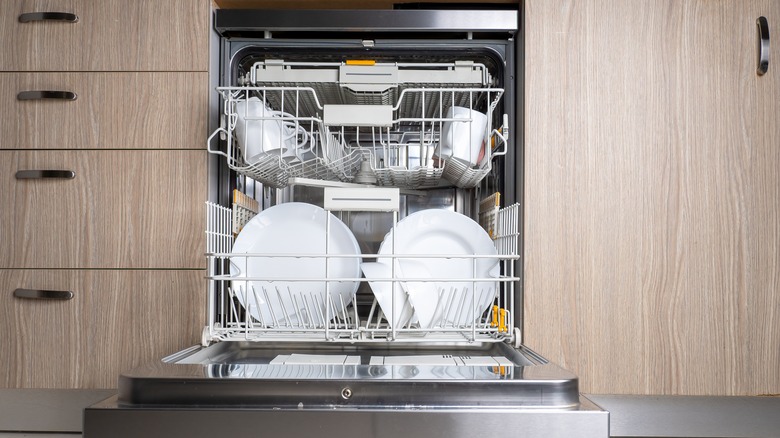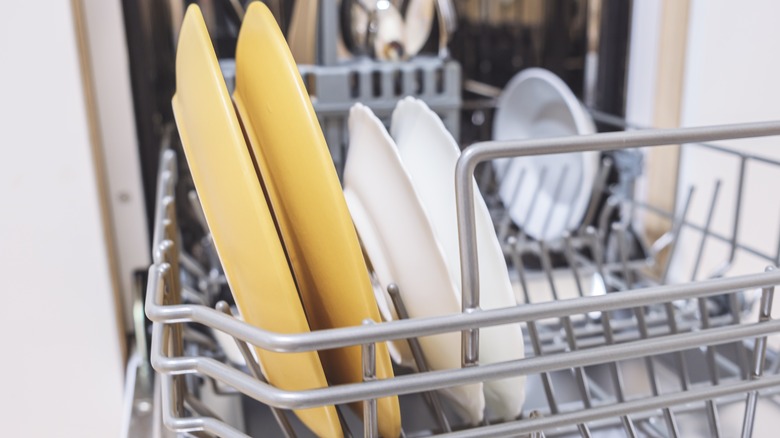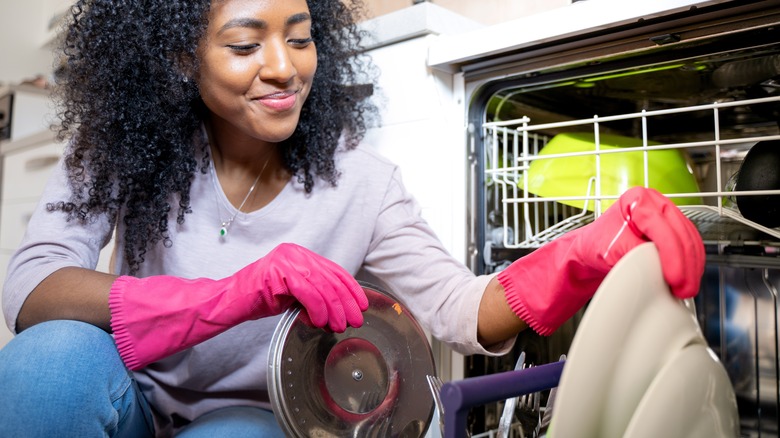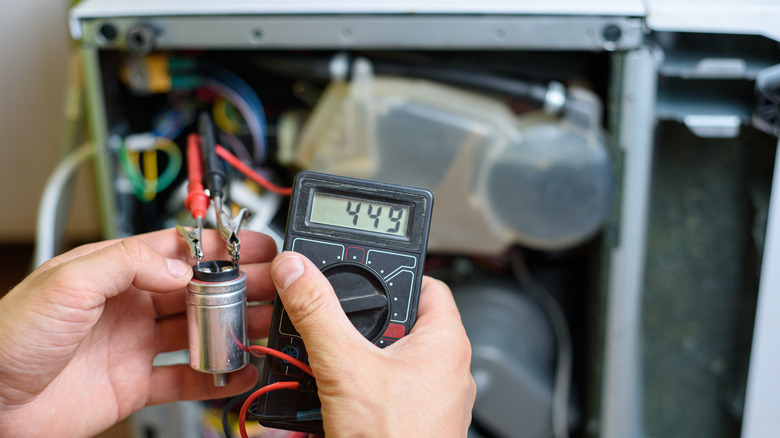5 Reasons Why Your Dishwasher Isn't Drying Your Dishes
The dishwasher is a necessity for many households. On any regular day, cleaning dishes involves arranging the load on the racks and running the program once the machine is full. However, sometimes, the dishwasher just decides to do half its job and fails to dry the dishes. This can be disappointing since you have invested your hard-earned money to enjoy the convenience of a dishwasher. So why is your dishwasher not drying the dishes? Well, to get to the root cause of the problem, it's necessary to first understand how exactly the dishwasher dries the load.
According to Atlantic Coast Appliance, the dishwasher essentially dries the dishes in two ways: heat drying and condensation drying. Heat drying involves the use of hot air from a heating element, which converts the water on the dishes into steam. Small fans drive out the steam, leaving the dishes clean and dry. Condensation drying, on the other hand, uses hot water during the rinsing phase. The steam from the last rinse cycle naturally gravitates to the cooler stainless steel walls, condenses, and runs off through the drains. Now, let's have a look at some of the reasons why your dishwasher may fail to dry your dishes.
1. You are not loading the dishwasher properly
Putting dirty dishes in the dishwasher does not guarantee clean and dry dishes after the cycle is complete. In fact, how well you load dishes in your dishwasher might just be the reason why your dishes come out wet. Before opening up your appliance or even calling the professionals, go back to the basics. How do you load the dishwasher? What do you place on the top and lower rack? Could you be overloading the dishwasher? These are some of the important questions you need to ask yourself before blaming the dishwasher for failing to dry your dishes.
According to Consumer Reports, the right way to load the dishwasher is to start with bowls, small cups, and glasses on the top rack, plates and other larger kitchenware on the lower rack, and silverware in the baskets. Also, consider placing the dishes at a slanted angle so that the spraying arm can access each individual item and allow the water to drain properly. You can always check your appliance manual if you are not sure how to load your dishwasher.
2. Not every material dries at the same rate
Look carefully when taking the dishes out of the dishwasher. Is the entire load not dry? Or are select dishes still wet? Usually, after the final rinse, the dishes retain heat. As described earlier, moisture from the dishes condenses on the cooler sides of the dishwasher into water. However, materials like plastic don't retain heat quite as much; therefore, not every drop of water evaporates. That's why, when you take out the dishes from the dishwasher, it is likely that the plastic ones, in particular, are not completely dry (via Compact Appliance).
Teflon, on the other hand, is hydrophobic, which means water collects in large globules. For this water to evaporate, you will need more heat when compared to other materials. Also, the fact that Teflon is insulated doesn't help the pans get hot enough to initiate evaporation. These characteristics make it quite difficult for pans with Teflon to dry in the dishwasher. So, if you are dealing with this problem, there is no solution or hack that will fix it. However, Teflon kitchenware is not meant to go into the dishwasher anyway; it is best cleaned by hand.
3. The rinsing aid has run out
Another reason your dishwasher is not drying your dishes is if the rinsing aid has run out. This component plays an important role, especially for dishwashers that use condensation as the drying technique. According to Bosch, the purpose of a rinsing aid is to reduce the white spots that form on clean glasses while also lowering the surface tension of water, allowing it to slide off the dishes easily. Consequently, the dishes dry faster. Go ahead and check whether the dishwasher has run out of rinsing aid, and if so, add just enough of the product into the designated reservoir.
However, if the reservoir is full but the dishwasher is still not drying dishes properly, the next likely cause is a blockage in the reservoir dispenser. Fixing this issue will require you to clean your dishwasher entirely. First, you will need to open the rinsing aid dispenser and remove the remainder of the product. Next, pour two cups of vinegar into a dishwasher-safe bowl and place it on the top rack of your empty dishwasher. Run the machine on the highest hot water setting mode with the rinsing aid reservoir's lid off. Once the cycle is complete, refill the dishwashing aid and the problem should be fixed.
4. A faulty heating element
If you are using an older dishwasher model and your dishes are not drying, chances are that the heating element is the main culprit and you might need to inspect it for damage, as per the Repair Clinic. Sometimes, the heat drying function needs to be activated manually. So, before freaking out and calling the repairman, try initiating the process manually. If the dishes are still not dry after a full cycle, then you might need to take a closer look. It is worth mentioning that you can test whether the heating element is working properly right from home, but when it comes to replacement, you will need to call the professionals to install a new one.
The heating element is located at the bottom of the dishwasher; any physical blemish on the surface, such as a crack or burn marks, might mean damage. However, if there is no damage, you might need to test the heating element for continuity using a multimeter. Accurate reading varies from one appliance to the other, so you will need to take out the manual and check for the continuity reading of your specific model. If the multimeter doesn't move at all, this often indicates no continuity, which means the heating element is dead and needs replacement.
5. A faulty high limit thermostat
Older dishwasher models that use a heating element have a protective feature (known as the high-limit thermostat) that prevents the device from rising above 207 degrees Fahrenheit (via Sears PartsDirect). Whenever the high-limit thermostat malfunctions, the heating element switches off before the completion of the cycle. If you notice the dishwasher is not drying the dishes effectively, the thermostat might need some examination. First, you need to gain access to the bottom panel of the dishwasher. Look for a silvery disk, which is the thermostat, and disconnect it from the wire.
Using a multimeter, you will then need to test the continuity. If the multimeter doesn't move, this indicates no continuity, which tells you that the high-limit thermostat is dead. Similar to the heating element, replacing the high-limit thermostat is best left to the trained hands of a professional. However, if you are good with wiring, this could also be a DIY project.
